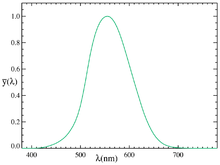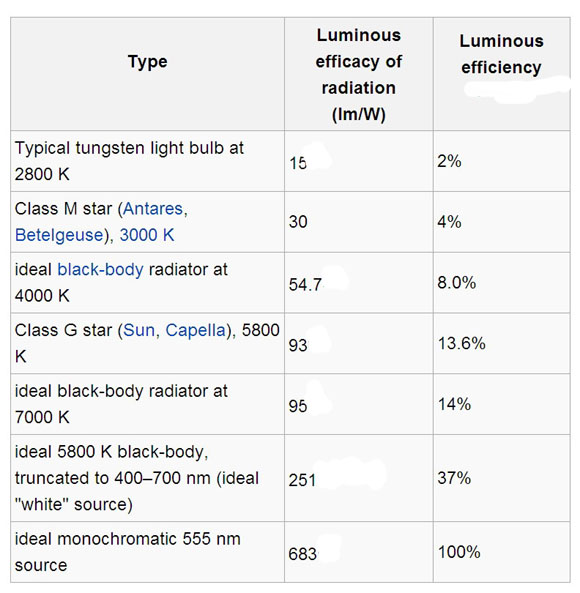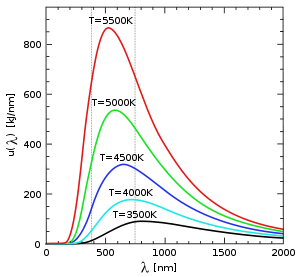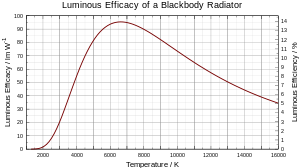Luminous efficacy is a measure of how well a light source produces visible light. It is the ratio of luminous flux to power. Depending on context, the power can be either the radiant flux of the source's output, or it can be the total power (electric power, chemical energy, or others) consumed by the source. Which sense of the term is intended must usually be inferred from the context, and is sometimes unclear. The former sense is sometimes called luminous efficacy of radiation, and the latter luminous efficacy of a source.
The luminous efficacy of a source is a measure of the efficiency with which the source provides visible light from electricity. The luminous efficacy of radiation describes how well a given quantity of electromagnetic radiation from a source produces visible light: the ratio of luminous flux to radiant flux.[5] Not all wavelengths of light are equally visible, or equally effective at stimulating human vision, due to the spectral sensitivity of the human eye; radiation in the infrared and ultraviolet parts of the spectrum is useless for illumination. The overall luminous efficacy of a source is the product of how well it converts energy to electromagnetic radiation, and how well the emitted radiation is detected by the human eye.
Efficacy and efficiency
In some systems of units, luminous flux has the same units as radiant flux. The luminous efficacy of radiation is then dimensionless. In this case, it is often instead called the luminous efficiency, and may be expressed as a percentage. A common choice is to choose units such that the maximum possible efficacy, 683 lm/W, corresponds to an efficiency of 100%. The distinction between efficacy and efficiency is not always carefully maintained in published sources, so it is not uncommon to see "efficiencies" expressed in lumens per watt, or "efficacies" expressed as a percentage.
The luminous coefficient is luminous efficiency expressed as a value between zero and one, with one corresponding to an efficacy of 683 lm/W.
Luminous efficacy of radiation
Explanation

The response of a typical human eye to light, as standardized by the CIE in 1924. The horizontal axis is wavelength in nm
Wavelengths of light outside of the visible spectrum are not useful for illumination because they cannot be seen by the human eye. Furthermore, the eye responds more to some wavelengths of light than others, even within the visible spectrum. This response of the eye is represented by the luminosity function. This is a standardized function which represents the response of a "typical" eye under bright conditions (photopic vision). One can also define a similar curve for dim conditions (scotopic vision). When neither is specified, photopic conditions are generally assumed.
Luminous efficacy of radiation measures the fraction of electromagnetic power which is useful for lighting. It is obtained by dividing the luminous flux by the radiant flux. Light with wavelengths outside the visible spectrum reduces luminous efficacy, because it contributes to the radiant flux while the luminous flux of such light is zero. Wavelengths near the peak of the eye's response contribute more strongly than those near the edges.
In SI, luminous efficacy has units of lumens per watt (lm/W). Photopic luminous efficacy of radiation has a maximum possible value of 683 lm/W, for the case of monochromatic light at a wavelength of 555 nm (green). Scotopic luminous efficacy of radiation reaches a maximum of 1700 lm/W for narrowband light of wavelength 507 nm.
Mathematical definition
The dimensionless luminous efficiency measures the integrated fraction of the radiant power that contributes to its luminous properties as evaluated by means of the standard luminosity function. The luminous coefficient is
where
- yλ is the standard luminosity function,
- Jλ is the spectral power distribution of the radiant intensity.
The luminous coefficient is unity for a narrow band of wavelengths at 555 nanometres.
Examples


Spectral radiance of a black body. Energy outside the visible wavelength range (~380–750 nm, shown by grey dotted lines) reduces the luminous efficiency.







